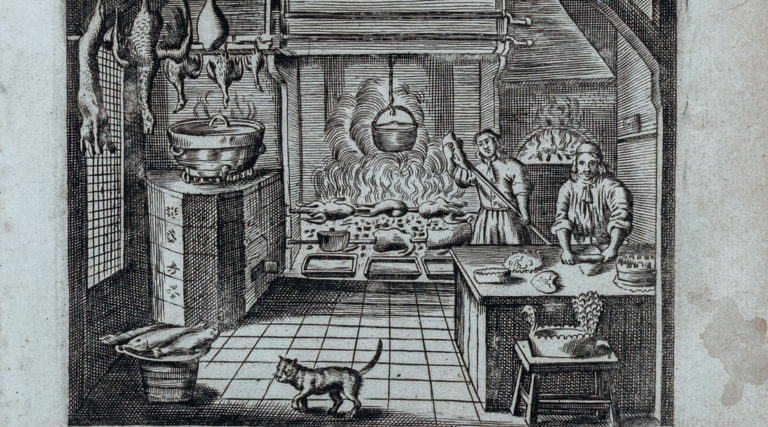Some time ago, I got hold of a copy of the most renowned Dutch cookbook of the 17th century: De Verstandige Kock of Sorghvuldige Huyshoudster (The sensible cook or careful housekeeper) from 1683. It is an amazing example of what the culinary habits were like in the 17th century. The cookbook has recipes ranging from expensive briskets, stews and preserves, to many recipes for pies. Recipes include seasonal products and nothing goes to waste: they ate every last bit of every ingredient. A short history of cooking in the Dutch Golden Age.
Kitchen gardening
Gardening was very popular with the 17th-century elite, just as it is today. A lot of rich merchants and nobility moved away from the crowded cities in the west of the Dutch Republic and started their own country estates outside the city. Many of these are still open for public today. These estates have widespread gardens surrounding the building in which you find many carefully planted herbs, vegetables, flowers and fruits. Maintenance was a hell of a job and took a lot of time, especially if there was a greenhouse to take care of as well. Soon, there were multiple books and manuals about how to maintain these country estates, like De Verstandige Hovenier (the sensible gardener) and Het Vermakelijck Landtleven (the joyful country life).
In 1667, two small books with recipes appeared: De Verstandige Kock and De Verstandige Confituurmaker (the sensible jam maker). They had 215 randomly ordered recipes in total. They were part of De Verstandige Hovenier. These two cookbooks were also published as one independent publication, to which De Hollandtse slacht-tijdt (the Dutch slaughter time) was added. This cookbook had 225 recipes which were neatly put into chapters, unlike their older versions. A third edition of the cookbook was published in 1669, as part of Het Vermakelijck Landtleven. This version had only 194 recipes. This version stayed unchanged until the latest publication in 1802. The cookbook in my library is a 1683 edition of this work.
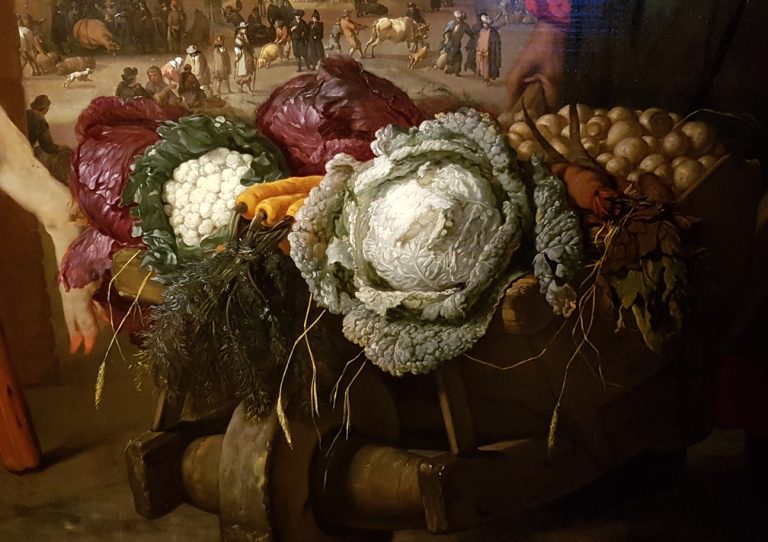
The Careless Housekeeper
It is unknown who wrote De Verstandige Kock, and it seems like the collection of recipes are not original. Approximately 40 recipes can be traced back to Eenen seer ende excellenten Cocboeck by the Flemish Carolus Battus, which was written in 1593. Another six recipes seem to be copied from Het Secreetboek by Battus, that appeared in 1600. It was very common that people copied each other’s recipes. Battus’ recipes are not original either. He copied recipes for his Cocboeck from a late 15th century handwritten cookbook from Gent (MS 476). Another Dutch cookbook writer, Antonius Magirus, took most of his recipes for his Koocboec oft Familieren Keukenboec (1612) from the Italian cookbook Opera dell’arte del cucinare (1570) from Bartolomeo Scappi. Scappi got his recipes from Platina, who got his recipes from Maestro Martino…
Copying texts could lead to mistakes. You would expect these mistakes if the recipes were copied from another cookbook, and not necessarily in another copy of the same book. When you look at the ‘koock-register’ (table of contents) at the first page of my De verstandige Kock from 1683, and compare them to the recipes in the actual book, you can not find recipes for ‘paeuwen’, ‘kiviten’ and ‘boeckweyte-koecken’ as were mentioned in the table of contents. The table comes from an older version of the cookbook.
17th century ingredients
De verstandige Kock was clearly written for the upper class. Nonetheless, the recipes seem quite simple when you compare them to French recipes, like the recipes from Le Cuisinier François by François La Varenne (1651). In contrast to the haute cuisine recipes in Le Cuisinier François, De verstandige Kock has more every-day recipes. Extraordinary dishes and showpieces, which are frequently pictured on Dutch paintings from the seventeenth century, are nowhere to be found. But these seem to be simple recipes are not what they like. Ingredients like sugar, Rhine wine, delicate kinds of meat, fish and vegetables were too expensive for the common people.
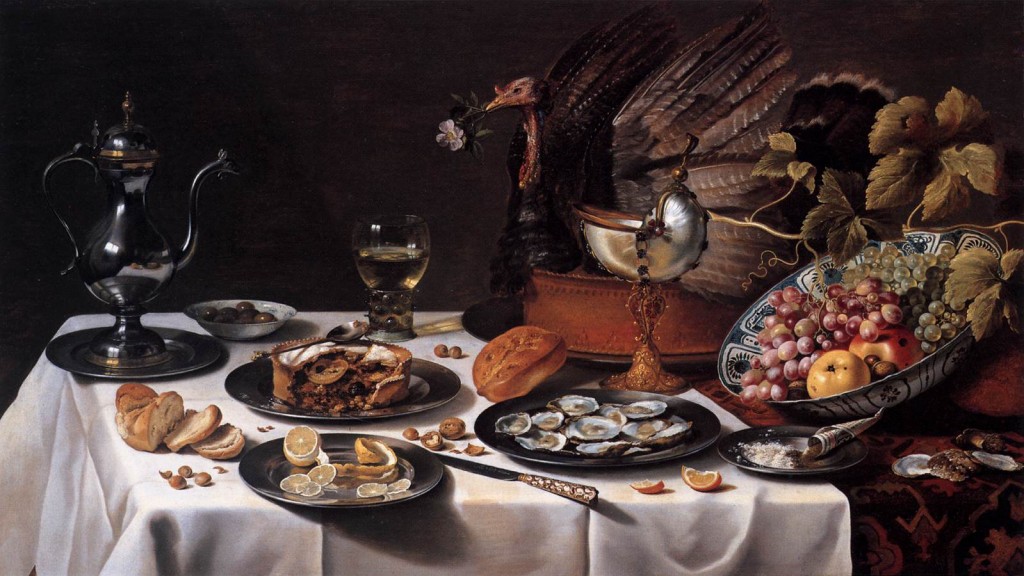
Meat and fish dishes are given plentiful in this cookbook. Every animal is prepared in different ways. Moreover, animals are eaten in its entirety, meaning that no part goes to waste. Parts we do not eat nowadays were considered delicacies back then, like buck testicles, sheep feet and calf tongue. Their favourite meat was beef, especially calf. Land reclamation in the west of the Republic added big patches of land to the country. This swampy, salty soil was not quite fit for agriculture, but it was extremely fit for cattle. The amount of livestock in The Netherlands grew in the 17th century due to these reasons. Cows provided the milk that was used for cheese and butter, and the young (male) calves landed on the plate.
The most remarkable aspect about the cookbook is the presence of a large variety of different kinds of luxury fruits and vegetables. De verstandige Kock is part of a garden manual, after all. The recipes with vegetables, fruits and herbs are mainly aimed at ingredients from their own gardens. We see many different non-native kinds of fruit. The lemons and oranges are grown in the greenhouse. New kinds of vegetables are cauliflower and celery, but the book contains also old vegetables that were re-discovered, like artichokes and asparagus.
New and rediscovered ingredients came to The Netherlands from all over the world and ended up in kitchen gardens. This, in combination with the growth of horticulture in The Netherlands, was the reason for the revaluation of vegetables in the middle- and upper classes in Dutch society. This trend was already going on in Italy during the Renaissance and finally got to The Netherlands in the 17th century. A recipe for a raw vegetable salad (the first recipe in the book) was unthinkable before this period.
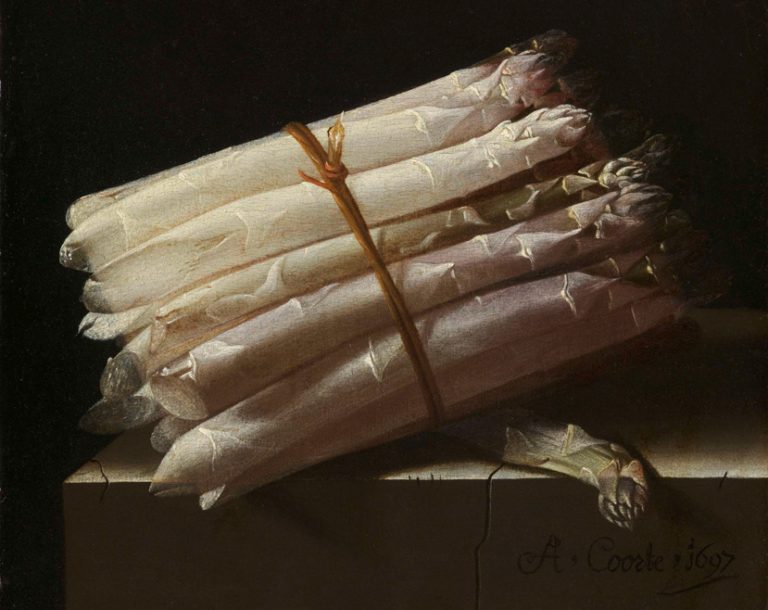
Recipes & Taste
The sweet & sour and spicy taste of the Middle Ages disappeared slowly in the 17th century. A new flavour palate of more sour and fresh flavours become popular in the second half of the century. This is represented in De verstandige Kock. These new flavours are recognizable in the sauces. We see far less strongly flavoured sauces as in the Middle Ages. What we do see, are more fresh sauces, often based on broths, with green herbs, verjus, citrus fruits and wine. These were often thickened with butter and egg yolks. This new cooking method came from France.
The use of spices in the kitchen declined. Spices were brought in on large scales by the Dutch East India Company, which was in her golden days during that age. This boosted the economy in The Netherlands and the middle classes got wealthier. They could affort spices as well. Spices in the Middle Ages were used to show wealth. Now that spices became more and more commonly used, they lost their function for the rich. The upper class was the first who stopped using them.
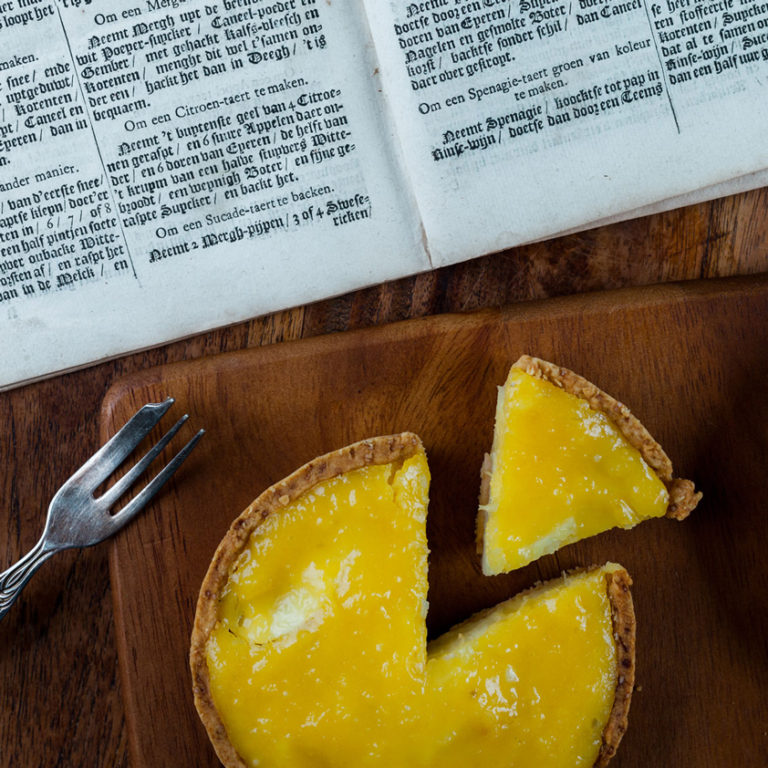
Cooking with De verstandige Kock
The recipes in De Verstandige Kock are easy to prepare in our modern kitchens. Even though the sheep feet and ram’s testicles are still not appealing to me, I really like the taste of calf tongue. The delicious pies, preserves, stews, cookies and salads are a great asset to our modern recipes. De verstandige Kock fits perfectly into our modern day culinary trends: pure, honest, no waste, homemade, slow-cooked and homegrown.

